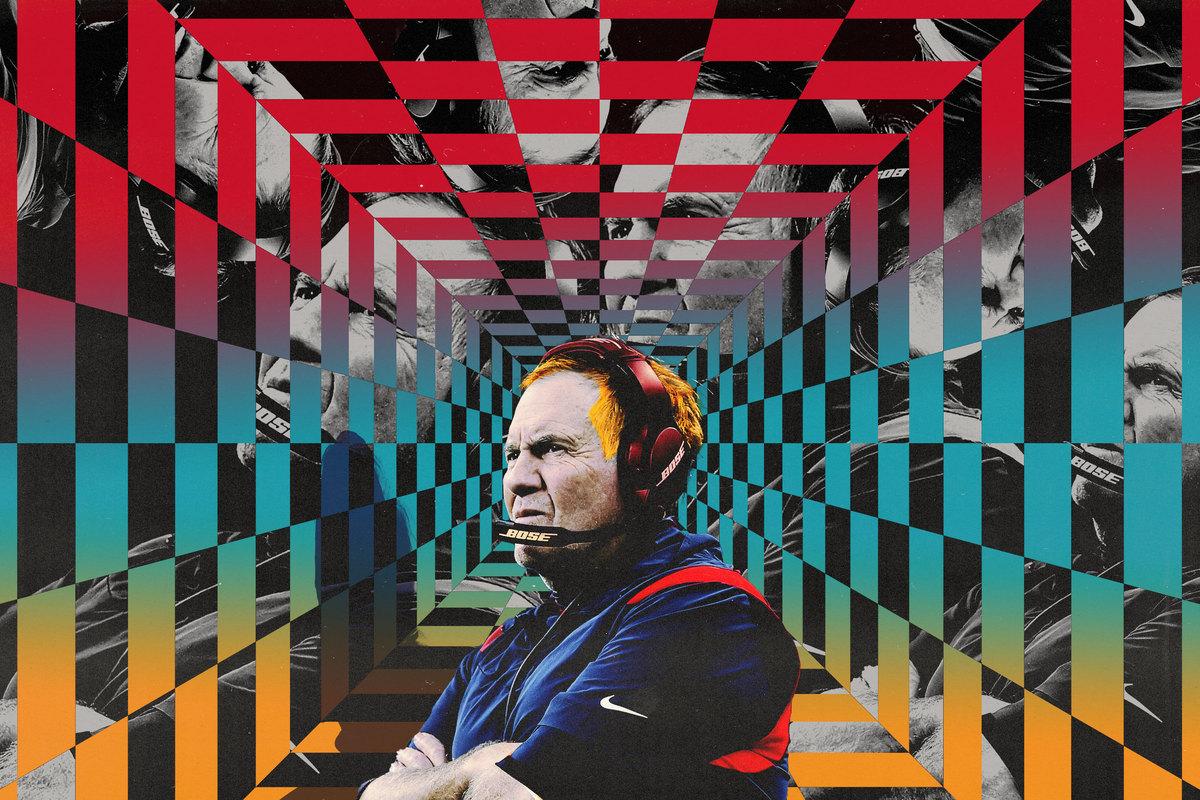
One of the lasting clips from an otherwise forgettable 2022 season for the New England Patriots was Mac Jones venting on the sideline during a 24-10 loss to the Buffalo Bills in December.
“Throw the fucking ball,” Jones yelled in frustration. “Fucking quick game sucks.”
After that game, Jones explained that he wanted to be able to push the ball downfield more often. That the Patriots offense needed to be more aggressive was a sentiment seemingly shared by the entire New England fan base that watched first-year offensive play caller Matt Patricia essentially sabotage what had been a productive offense in 2021, Jones’s rookie year. After Josh McDaniels departed in early 2022, the Pats personnel stayed largely the same, and Bill Belichick replaced McDaniels with longtime NFL defensive coach Matt Patricia—who then overhauled the entire structure of the offense. The results of this unorthodox move from Belichick were predictably disastrous: The Pats fell to 24th in offensive DVOA after ranking ninth the previous season, and Jones’s fall was even steeper. He was a league-average passer in 2021 based on most efficiency metrics—an impressive feat for a rookie passer—but only Houston’s Davis Mills and the Jets’ Zach Wilson were worse in expected points added in 2022, according to TruMedia.
At this time last year, Jones appeared to be New England’s future. Now, it’s unclear how committed Belichick is to the 2021 first-round pick beyond next season. Patricia is gone, back to coaching defense with another organization, and Belichick has handed the offense—and Jones’s development—to Bill O’Brien, who, for all his personnel missteps in Houston, is an experienced coordinator and play caller and should get better results out of the young quarterback. But outside of the coordinator, the actual offense won’t look dramatically different this fall. We should expect the play-calling to be better—it couldn’t be worse—so it will be up to Jones to determine how much better the offense will be. And his performance in 2023 could determine Belichick’s next big move—and whether the Pats will be in the market for a new quarterback next offseason.
Belichick’s message seems to be that if offensive coaching and quarterback play were the big issues the team had last year, simply changing the former should solve the latter.
While getting Jones’s development back on track appeared to be the team’s top priority heading into this offseason, it’s fair to wonder about Belichick’s long-term vision for the offense and his young quarterback now that the bulk of the team-building work for 2023 is complete. Despite plenty of predraft rumblings that the Pats might be shopping Jones and could be in the mix to draft a first-round QB, Jones remains the starter, and the rest of the offensive roster remains largely intact. Riley Reiff will take over at right tackle, receiver JuJu Smith-Schuster was signed to replace Jakobi Meyers, and Mike Gesicki will take over for Jonnu Smith as a roving tight end to complement Hunter Henry. The Patriots didn’t take an offensive player until the third day of the draft, and they even traded up for a kicker before adding a pass catcher. New England used its first two picks on cornerback Christian Gonzalez and pass rusher Keion White, bolstering a defense that didn’t appear to need much help after finishing third in defensive DVOA last season.
Now, in an attempt to figure out what Belichick’s offensive endgame is here, and to determine if the damage Patricia caused in his short time running the offense is fixable, it’s helpful to look back at exactly what happened last season.
Perhaps the biggest schematic change under Patricia was the decision to scrub the fullback position from the Pats’ roster in an attempt to model their offense after Sean McVay’s highly successful system built around a strong run game and play-action passes. That proved too difficult for Patricia to pull off in his first time overseeing an NFL offense. Patricia’s run game was poorly designed and often left linebackers unaccounted for in the blocking scheme. He also seemed to have no idea how to dial up deep shots in the play-action passing game. Jones doesn’t have the arm talent and playmaking instincts to consistently run a viable deep-dropback passing game without effective play-action. The result was an incoherent mess of an offense that lacked any semblance of an identity aside from the heavy use of the quick game Jones despised so much.
Sure, Jones could have voiced his displeasure with the play-calling in a more diplomatic and private manner than a sideline outburst during a nationally televised prime-time game, but he wasn’t wrong. Quick game does fucking suck, and the league-wide results back that up. The efficiency of those short passes, which are designed to get the ball out of the quarterback’s hands quickly and neutralize a pass rush, is on par with that of your typical run play—according to Sports Info Solutions, teams averaged minus-0.03 EPA per run compared to minus-0.08 EPA per quick-game pass—and the goal is ultimately the same: to pick up just enough yards to keep the offense ahead of the chains. This style of offense is a good solution for teams with a faltering run game, but it’s not something you want to serve as the foundation of your passing game. If play-action passes are football’s version of basketball’s corner 3s, then the quick game is a midrange jumper. Unless you have a Tom Brady or Drew Brees—or, to extend this metaphor, a Michael Jordan or Kobe Bryant—it’s an inefficient style of play.
That proved to be the case for the Pats in 2022; Patricia and Jones led a punchless offense that had to put together painstakingly long drives to find the end zone, and there was no margin for error. If Jones missed a read or took a sack or if the team committed a pre-snap penalty or had a run play blown up in the backfield, it would completely derail a drive. And those negative plays happened a fair amount. In the end, the Patriots offense scored just 31 touchdowns, their lowest total since 2000: Belichick’s first year in New England and the last season before the Brady era began.
Going into the offseason, it seemed like retooling the offensive scheme that didn’t work for Patricia or Jones would be Belichick’s top priority. But it now appears that wasn’t the case, leading some to question Belichick’s grip on the reality of the modern NFL, where a prolific passing game is viewed as a prerequisite for long-term success. While the rest of the league has spent the last few years trying to keep up with Kansas City’s offensive machine, Belichick doesn’t seem all that interested in participating in an arms race—at least not until he figures out what he has at quarterback.
Patricia’s incompetence can’t fully explain Jones’s regression. Jones’s completion percentage dropped, and, per Pro Football Focus, his turnover-worthy play rate went up slightly despite him playing in a significantly more conservative offense. Even when accounting for the poorly designed offense, Jones was bad, so there are still plenty of questions about his ability to develop into a franchise quarterback as he heads into his third season.
You can make a case that the schematic offensive changes Patricia made should have benefited Jones. Compared to his rookie season, Jones played more from the gun in 2022, and the early-down offense featured more pass calls that should have made better use of his sharp processing and accuracy as a passer. Those were the skills that got him drafted in the first round, so the change in philosophy made a lot of sense—in theory, at least. In reality, it was a mess.
I’m not sure any quarterback would have thrived playing under Patricia, but the fact that Jones barely survived—he did get benched for Bailey Zappe at one point—has to cast some serious doubt on his long-term viability. Even if quick game does indeed suck, Jones fits the archetype of a pure pocket passer, and he probably can’t function without short passes being the foundation of his offense. And if it turns out Jones is useful only in a play-action-heavy scheme built around the run game, well, you can find those quarterbacks anywhere—just look in Kyle Shanahan’s recycling bin.
The most obvious short-term solution to fix Jones would be for O’Brien to reinstall the framework of McDaniels’s 2021 offense that set Jones up for success as a rookie, but that’s not what the Patriots are doing. All indications are that O’Brien’s overall offense will largely look the same as Patricia’s, only more refined. During his time in Houston, O’Brien called a lot of quick game and did not use a lot of play-action. The Pats’ run game will likely be called differently under O’Brien, but the passing game will look awfully similar to what we saw in 2022. The same goes for offensive personnel. Smith-Schuster is a like-for-like replacement for Meyers, and Gesicki will offer more receiving production than Jonnu Smith did as New England’s TE2, but he will largely play the same role as the team’s roving tight end in 12 personnel sets. Jones, meanwhile, will be asked to do a lot of the same things—he’ll hopefully just get more support from his offensive coordinator this time around.
That Belichick didn’t go out of his way to make his young quarterback’s job easier this season may be a sign that Belichick is declining as a team architect. Or perhaps Belichick is playing a longer game, and the lack of investment in better offensive players is putting pressure on Jones. If Jones can’t keep his head above water in an offense that should fit his skill set when he has competent coaching, it’s probably time to move on anyway. Belichick has kept his options wide open moving forward with the team that’s slated to have its full complement of draft picks and over $100 million in available cap space next offseason. If Jones rebounds in O’Brien’s offense, New England has the means to bolster his supporting cast. If not, and if Jones proves he’s not a quarterback worth building around, the front office has the means to tear down the offense and rebuild from scratch.
Per Spotrac, only six players on the offense have contracts that extend beyond 2024: last year’s first-round pick, guard Cole Strange; Zappe, the Patriots’ QB2; 2022 second-round receiver Tyquan Thornton; backup running back Pierre Strong Jr.; third-string center Chasen Hines; and Smith-Schuster. Outside of Strange, there isn’t a clear building block for the future on the roster. That’s a lot of open spots to fill. There’s no telling what this offense will look like a year from now, and that’s not necessarily a bad thing! Even if Belichick doesn’t have a long-term plan, he’ll have plenty of options.

